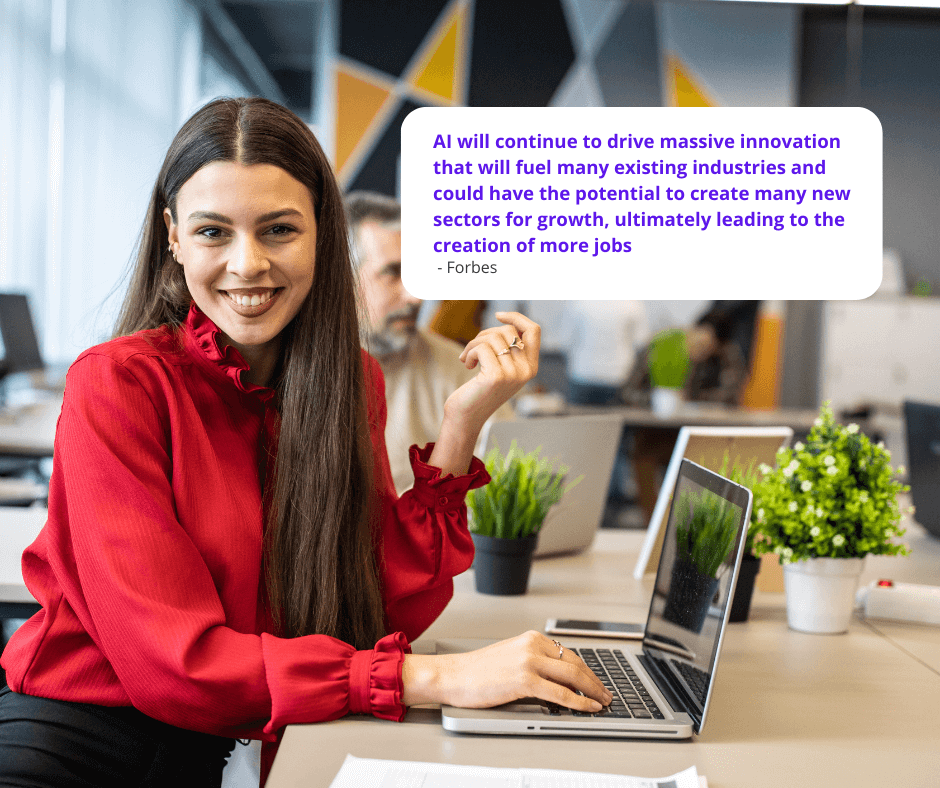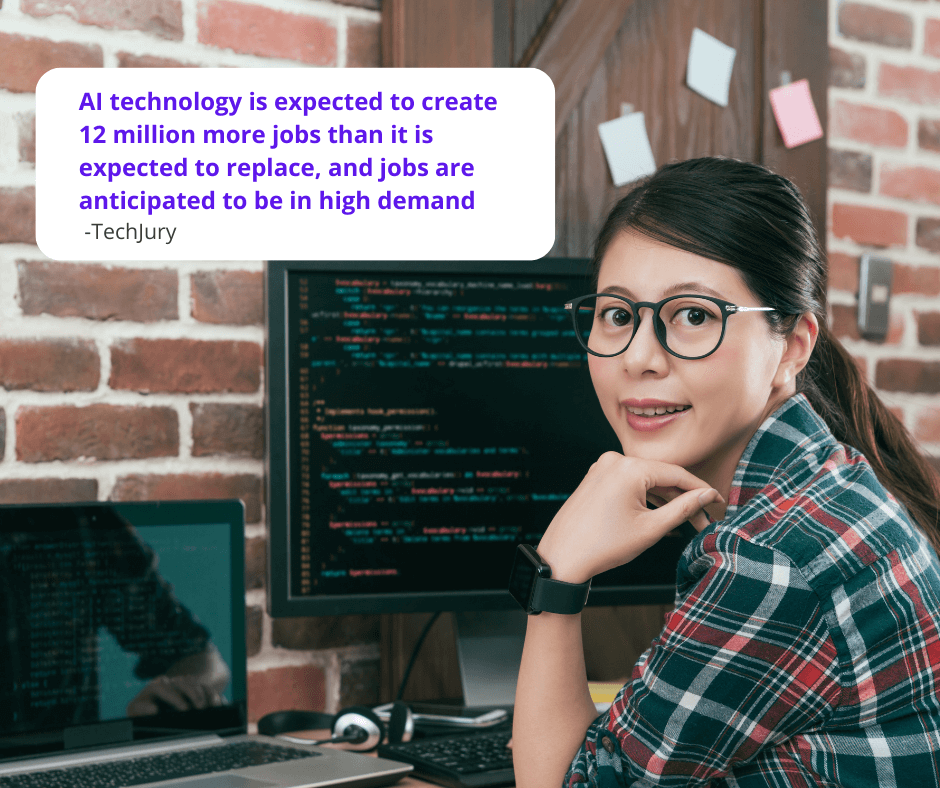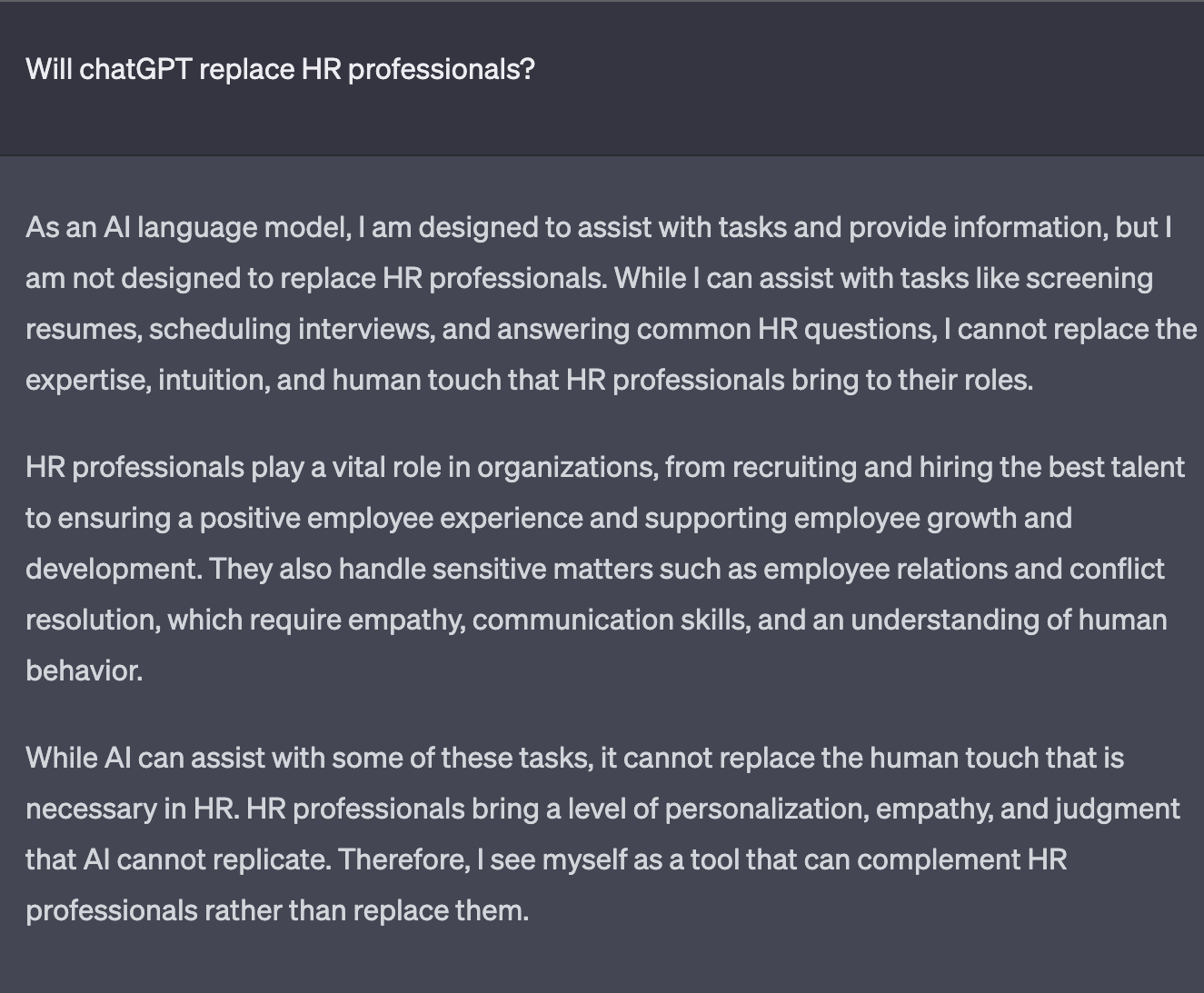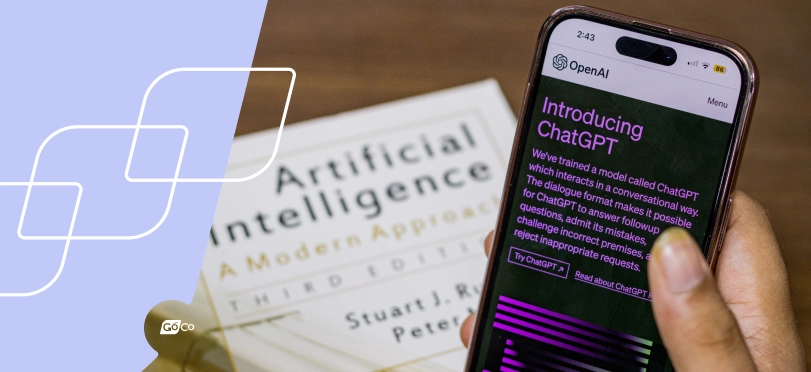6 Ways HR Pros Can Use chatGPT as a Personal Assistant [+examples]
In just a few short months since its launch, chatGPT has shaken up countless industries, including HR. But what exactly is this AI tool, and how can HR pros use it?
by Anna Coucke - April 24th, 2023
A flashy new kid on the block is taking countless industries by storm, including HR – chatGPT. Eightfold AI’s report, The Future of Work: Intelligent by Design, surveyed 250 HR leaders, and the majority stated that they are already using AI (artificial intelligence) tools such as chatGPT in HR functions, including employee records management, processing payroll, benefits administration, recruitment and hiring, performance management, and onboarding.
But just how can HR pros utilize chatGPT to enhance their work? Even though it's a new tool, chatGPT can already simplify and automate many aspects of HR. Let’s examine exactly what chatGPT is, what it’s capable of, and how HR professionals can use it as a personal assistant – with a few examples.
What is chatGPT?
In just a few short months since its launch, chatGPT has shaken up industries, including education, copywriting, coding, and data entry, just to name a few. But what exactly is it?
ChatGPT, which stands for Chat Generative Pre-trained Transformer, may initially seem similar to a traditional chatbot or voice assistant. However, its capabilities can go much further since it is based on an LLM (large language model) that is trained to learn vast quantities of information from all over the internet, including social media, search engines, books, websites, and more.
52 FREE chatGPT Prompts for HR Pros
Start Automating!
Simply put, chatGPT is a computer program that uses machine learning (ML) and natural language processing (NLP) to directly answer text-based questions and prompts in a way that mimics human conversation. At its core, chatGPT is a tool that can erase mundane and time-consuming tasks in many professions that might otherwise take hours of brainstorming, planning, and research.
How to use chatGPT
Currently, chatGPT is still in its research phase and is free for anyone to use after signing up for an account, with a paid premium version launching soon. Other 3rd party AI tools are available that build on chatGPT and are fine-tuned for specific industries.
Once you are signed up, chatGPT is relatively straightforward – you type text into the chat box, and chatGPT will generate a response. However, utilizing this tool properly means you must ask chatGPT the right questions to get the best answers. To do this, you need to know how to write effective prompts.
92% of HR leaders plan on increasing
their use of AI in the next 12-18 months
Writing Effective Prompts
When crafting effective prompts, there are a few best practices that are important to consider to get the best out of chatGPT:
Be as specific and provide as many details as possible
Use simple language
Provide context
For example, instead of asking, “What are some birthday party ideas?” a better prompt that would generate more personalized and useful results would be, “What are some birthday party activity ideas for a 10-year-old who enjoys Minecraft and puzzles?” Like a human, chatGPT can generate more specific answers if given more details and context.
If you aren’t getting the results you are looking for or if they are too broad, try experimenting with different prompts and details. You can also assist chatGPT by telling it how long you want the response to be, how many items you want in a list, or by giving examples. Like any tool, learning how to get the best out of chatGPT for your needs can take trial and error.

6 HR tasks you can automate with chatGPT
Now that you have a basic understanding of chatGPT and how it works, you may wonder how exactly you can utilize it. As an HR professional, implementing chatCPT as a virtual assistant can help you knock out tedious tasks and streamline processes – giving you more time to focus on your team.
1. Automate recruiting and onboarding
There are several ways you can use chatGPT to streamline and automate recruiting and onboarding. It can create the written content needed for recruiting and onboarding, such as job descriptions and posts, interview questions, offer letters, and more. Once chatGPT is given information on job requirements and company culture, it can even generate personalized job descriptions that are more likely to attract the candidates the company is searching for.

AI can also assist HR in the preliminary screening and filtering of candidates as a chatbot that asks them pre-determined questions, analyzes their responses, and then determines their strengths, weaknesses, and sentiments to determine which candidates are the most qualified for the position.
.png)
2. Format job posts & more in HTML
In addition to creating written content such as job descriptions, chatGPT can easily format them into HTML for you. Instead of having to receive training on HTML or task someone else with the job of converting a long post into HTML, chatGPT can do so in seconds – relieving technical bottlenecks so content can be published or updated quickly.
.png)
3. Streamline employee support inquiries
HR pros can train chatGPT to answer employee support inquiries, and then integrate it into their HRIS or employee portal to quickly assist employees in finding the answers to their questions.
Once you identify the common questions HR receives, you can train chatGPT on recognizing and responding to them by giving it information from existing FAQs, employee handbooks, and other documentation.
.png)
4. Create an effective employee engagement program with AI-driven surveys
ChatGPT can also be used to create and conduct surveys for employees, including writing questions, answers, and descriptions. You can also specify in your prompts whether you would like certain or all questions to be multiple-choice or open-ended.
The AI can then analyze the results of the surveys and suggest solutions to issues, how employees’ needs can be met with available resources and budgets, and much more.
.png)
5. Use generative AI as a consultant to improve your company culture
ChatGPT can act as a consultant to enhance and improve company culture based on existing documentation and employee feedback. Some examples of its abilities include:
Creating core values based on what is important to your company
Coming up with ideas for activities to improve employee engagement
Analyzing survey results and suggesting how to implement changes
-1682091118.png)
6. Analyze employee and business data to find areas of improvement
Just as it can analyze survey results and suggest solutions, chatGPT can also analyze employee and business data to find areas of improvement by identifying correlations and making predictions.
It doesn’t stop there – chatGPT can also use this data to set performance targets and develop training or other initiatives to address the issues it identifies.
.png)
Ethical & Security Considerations
With the excitement of chatGPT’s capabilities, there have also come concerns for cybersecurity surrounding information fed to it, as well as bias and inaccuracy in its answers. Staying vigilant about the information you give AI and being skeptical of the information it provides you are paramount, especially at this point in its lifecycle.
Since chatGPT curates information from so many sources on the internet – both credible and not-so-credible – it is vital to edit and fact-check the information it generates. Fact-checking is especially important as chatGPT currently doesn’t provide sources for the data generated. Remember that chatGPT is still in its experimentation phase and has limited information on events after 2021.

Ensure you do not enter any sensitive information into chatGPT that you wouldn’t otherwise publicly publish or disclose, including company information and private identifying information about yourself and your colleagues. This is because machine-learning software like chatGPT ingests the data it is fed and uses it to learn and better answer future queries. For an example of what not to do, chatGPT made the news for leaking source code for Samsung that employees shared with it. A good rule of thumb is that if you wouldn’t publish the information publicly, don’t enter it into chatGPT.
Will chatGPT Replace HR Professionals?
With advances in AI technology happening rapidly, many have fears that tools like chatGPT will replace human jobs and even make entire professions obsolete. However, it is more likely that AI will continue to function as a tool to erase the more mundane aspects of many jobs.
This will leave human professionals more time for tasks that require uniquely human aspects, including relationship-building, decision-making, and original thought and creativity.
I asked chatGPT directly if it would replace HR professionals, and it had this to say:

So, although chatGPT can make your job easier, it isn’t coming for your job. After all, you are in human resources – and that will always have tasks and responsibilities that require a human.
Final Thoughts
AI can already do so much for HR – and it’s just getting started. From automating aspects of recruiting and onboarding to analyzing employee and business data and making suggestions for improvement, chatGPT is able to make mundane tasks so much easier by functioning as a personal assistant. Beyond chatGPT, AI has the capabilities to go even further for HR, including image design, text-to-video production for processes like employee onboarding, and much more.
It can’t do everything, though. For tasks such as HR workflows that take a bit more than chatGPT to automate, check out GoCo and everything our flexible platform can offer for your HR team.
chatGPT FAQs for Human Resources
-
ChatGPT is a computer program that uses machine learning (ML) and natural language processing (NLP) to directly answer text-based questions and prompts in a way that mimics human conversation. It is a tool that can erase mundane and time-consuming tasks in many professions. It is based on an LLM (large language model) that is trained to learn vast quantities of information from all over the internet, including social media, search engines, books, websites, and more.
-
Currently, chatGPT is still in its research phase, and anyone can use it after signing up for an account. Once you are signed up, you type text into the chat box, and chatGPT will generate a response. However, you must ask chatGPT the right questions to get the best answers. To do this, you need to know how to write effective prompts.
-
When crafting effective prompts, there are a few best practices that are important to consider to get the best out of chatGPT. These include being as specific and providing as many details as possible, using simple language, and providing context. Like a human, chatGPT can generate more specific answers if given more details and context.
-
HR professionals can utilize chatGPT to automate many aspects of HR, including employee records management, processing payroll, benefits administration, recruitment and hiring, performance management, and onboarding. They can also train chatGPT to answer employee support inquiries and conduct surveys for employees.
-
Yes, chatGPT can easily format written content into HTML. Instead of having to receive training on HTML or task someone else with the job of converting a long post into HTML, chatGPT can do so in seconds – relieving technical bottlenecks so content can be published or updated quickly.
-
Currently, chatGPT is in its research phase and is free for anyone to use after signing up for an account. However, a paid premium version will be launching soon. There are also other third-party AI tools that build on chatGPT and are fine-tuned for specific industries.
-
HR professionals can utilize chatGPT to simplify and automate many aspects of HR, allowing them to focus on more important tasks such as team building and engagement. ChatGPT can also help reduce human error and bias in tasks such as recruiting and onboarding, making the hiring process more efficient and inclusive.
Recommended Posts
4 Reasons to Automate Employee Requests
Blog Articles
Search...
Product
GoCo
Resources
Articles
eBooks
Webinars
Customer Stories



